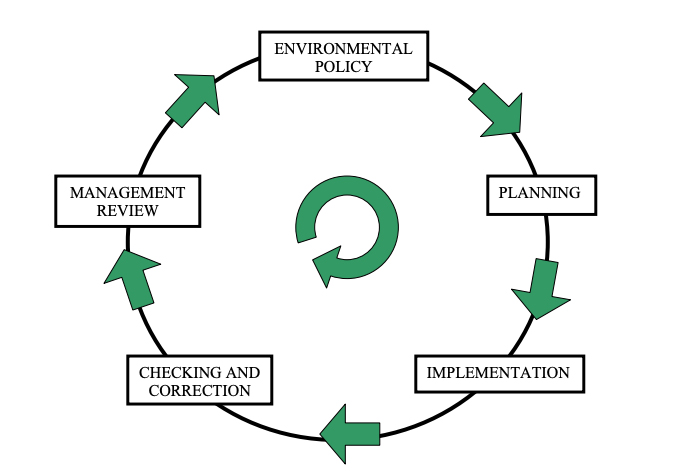What is an environmental management system (EMS)?
In its most simple terms, an environmental management system (EMS) is an approach to identifying the ways that the environment is impacted by our work activities. An EMS helps set priorities for action and it challenges each and every employee to continually look for ways to lessen those impacts and to protect the environment.An EMS is defined as a self-correcting and continual improvement system that seeks to reduce environmental impacts associated with a facility's activities while helping to ensure compliance with environmental regulations. It provides a structured method for incorporating environmental considerations into day-to-day operations while promoting continual improvement of the environment and human health. The EMS guides NIEHS as it integrates environmental responsibility in its decision-making at all levels and in the conduct of all institute programs and practices.
- Why does NIEHS have an EMS?
As the premier federal environmental health research institute, NIEHS embraces environmental protection as a core value in the conduct of our research programs. Through implementation of an EMS, NIEHS supports its mission, enhances existing environmental protection programs, and reduces environmental impacts associated with its activities. - How is an EMS structured?
Like most EMSs, the NIEHS EMS follows the Plan Do Check Act structure provided by the ISO 14001 EMS Standard. This involves a five-step process that addresses each of the following key elements of the ISO Standard:-

Step 1: Environmental Policy
The EMS development process starts with establishing an Environmental Policy that is tied to the organization’s mission. - Step 2: Planning
The planning step consists of identifying regulatory and other requirements; identifying processes, resources, and significant impacts; identifying pollution prevention opportunities; developing objectives and targets for improvement efforts; and creating a planning, programming, and budgeting system. - Step 3: Implementation
The implementation step consists of defining the structure, responsibilities, and programs; implementing training; creating the EMS documentation (including document control and record keeping); communicating the EMS to personnel; developing and implementing standard operating procedures [SOPs]; and developing and implementing emergency preparedness and response procedures. - Step 4: Checking and Correction
The checking and corrective action step includes monitoring and measuring (e.g., internal assessments), problem and cause identification, corrective and preventative action implementation, and an EMS Review. - Step 5: Management Review
In the management review step, upper management reviews the EMS, including the results of internal assessments. Modifications to the EMS are made, as necessary, to ensure compliance. The management review is designed to ensure continual improvement of the EMS, taking into account the results of checking and corrective actions undertaken in Step 4.
-
- What are NIEHS significant aspects?
Environmental aspects are elements of an organization's activities, products or services which can interact with the environment. Aspects are considered to be significant if they are regulated by an environmental permit. Aspects can also be designated as significant based an evaluation of their potential impact to the environment or human health. This occurs through a prioritization of activities and processes involving rating factors such as frequency of activity, severity or degree of impact, potential scope of an impact, probability of an adverse impact, legal risk, and resource consumption. Our current significant aspects are as follows:- Air Emissions
- Chemical Waste
- Radioactive Waste
- Storm Water Releases
- Toxic Releases
- Waste Water Discharges
How are NIEHS employees made aware of the EMS?
An effective EMS provides opportunities for employees to understand how their work activities, products, and services can impact the environment. EMS updates are periodically provided to all employees through our existing online information resources and email announcements.All new laboratory employees are required to attend the Introduction to Health & Safety at NIEHS course. This course has been updated to include informational awareness about the NIEHS EMS. The Introduction to Health & Safety course is offered several times per year and is also open to seasoned employees seeking to refresh their knowledge of our health, safety, and environmental protection programs.
Does NIEHS participate in other environmental leadership programs?
NIEHS is recognized as an Environmental Partner by the North Carolina Department of Environmental Quality under their statewide Environmental Stewardship Initiative. This is a voluntary program for companies and organizations located in North Carolina that accept a commitment toward improving their environmental performance beyond traditional levels of compliance. Program requirements include a commitment to environmental compliance, establishment of environmental performance goals, implementation of an EMS, and annual reporting on the progress toward achieving environmental performance goals.NIEHS has received a Wildlife and Industry Together (WAIT) certification from the North Carolina Wildlife Federation. The WAIT certification program is focused on maintaining the natural ecosystems of the NIEHS Campus and educating employees regarding native animal species. Once granted WAIT certification, an organization is expected to show evidence of continuing enhancement of wildlife habitat and advancement of an employee education program. Educational materials recently developed for employees include the Birds of NIEHS (216KB), Reptiles of NIEHS (749KB) and Biters and Stingers of NIEHS (3MB) handouts. In addition, NIEHS has developed a written brochure, titled Discovery Lake Self-Guided Nature Trail (1MB), describing plant and animal life for 15 highlighted points of interest along the self-guided NIEHS Lake hiking trail.
Frequently Asked Questions – Environmental Management System
to Top
Last Reviewed: December 19, 2025


